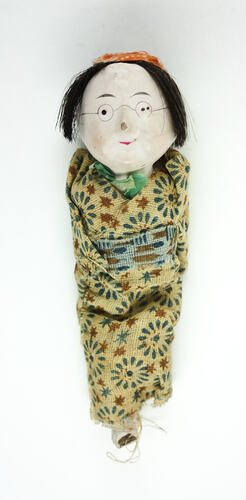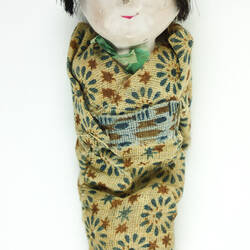Summary
Small Japanese-style doll wearing printed kimono, with bisque (or similar) hands, feet and head, and cloth body. Head is possibly finished with gofun, an oyster shell mixture; face is simply hand-painted. It probably dates from the Meiji period, 1868-1912; its provenance suggests a date range of 1890-1910.
Japanese doll-making (ningyo, or human form) is a traditional craft. Ichimatsu-type dolls represent young girls or boys, correctly proportioned, typically with flesh-colored skin, glass eyes (although not in this case) and jointed or floppy arms, made to hold, dress and pose.
Part of a collection of heirloom dolls and toys of Japanese origin or design, brought to Australia sometime in the late 1960s or 1970s by members of the Roche family from England. They were the playthings of Ruth Roche's mother Mary Paddison (later Mary Granlund, or 'Mrs G'), born in London in 1893, one of 11 children. She was raised near Tiverton, Devon, where her father was Second Master at Blundell's Preparatory School. Her family had connections in many parts of the world, although it is not known how Mary acquired the dolls and toys.
Physical Description
Small doll with off-white bisque (or similar) head, hands and feet, and cloth body. Hand-painted face, with simple eye shapes and small pink mouth. Painted on glasses. Head trimmed with black fibre hair, parted at centre, topped with small cap, orange with white spots. The doll wears an ankle-length garment with waist band, kimono-style, made from a coarse weave (hessian style) fabric printed in a blue and brown floral and star pattern on fawn background, with belt of similar fabric but pale blue background. Thin green undergarment visible at neckline. Nose and toe chipped. Dimple in proper right cheek, probably a manufacturing error.
More Information
-
Collecting Areas
-
User
Mary Paddison, Tiverton, Devon, England, Great Britain, circa 1896-1906
-
Date Made
-
Classification
-
Category
-
Discipline
-
Type of item
-
Object Dimensions
40 mm (Width), 40 mm (Depth), 133 mm (Height)
-
Keywords


